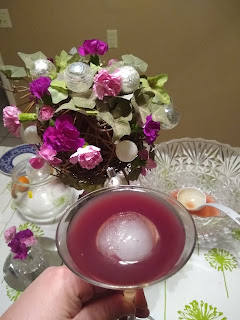 |
| Setting out Kansas transects June 2020 |
Um, I mean I go outside and count how many plants are there.
This somehow frequently makes me giggle. When I was interviewing for my current job, I asked why Plant Physiology was part of the job description when one of my colleagues is an algal physiologist seemingly well-suited to teaching the course. The algal physiologist explained that he is not really a physiologist, he is more of an eco-physiologist and went on to explain what he does (physiological responses of algal grown in different light conditions to different types of radiation). It was an interview and I wanted the job, so I didn't blurt out, "You know that I count plants, right?"
 |
| A 3m x 3m plot Kansas 2020 |
Most years I go to Kansas where I re-find plot corners in a prairie hay meadow (now using a metal detector called "The Gold Digger") based on triangulation from fixed fence posts (hand held GPS is still not nearly as accurate as walking 45m from that post and 55m from this one). A dear friend and I search 3m x 3m plots looking for every prairie turnip (Pediomelum esculentum) within the plot. When we find one, we record its location based on the tape measure that is temporarily making a plot frame and record its height, spread, and reproductive status. We eventually compare to the individual information from the previous year, so not only do we have a sense of what is happening to the population overall, we also know fates of individuals. Eventually, these year-to-year individual transitions are combined into a matrix to make projections about the population as a whole. I counted these particular plots in 2001, 2002, 2003, 2004, 2013, 2014, 2015, 2016, 2019 and 2020. I have also counted a population in Nebraska 2002, 2003, and 2004 and a population in Montanta 2001-2004.
 |
| Flags are bases of Cyclanthera Sept. 2019 |
In Oklahoma, I am tracking a population of annual vines, so there is no year-to-year survival. Since 2010, students and I have documented the location, size and reproductive status of every plant in a woodland 5 miles from campus. While most years the population has had 100-400 individuals, we have counted as few as 11 (2011) and as many as 2,748 (2019). We do this in September and October, when the plants are flowering and fruiting. Concerned that I was missing a critical step in the life cycle, in 2016 we started a spring plot count and in 2019 and 2020 I am re-visiting the plots all summer so that I can document within-season survivorship. In 2018 there were more seedlings in the plots in May than there were in May 2019, even though there were only 44 plants in the fall 2018 population compared to 3,000 in fall 2019. Locations are recorded as vectors (compass degrees plus distance) from marked reference trees.
Most years I also document the populations of invasive plants, tree-of-heaven, johnsongrass, and giant reed in and around my small town. These involves actually counting trees and estimating their size and measuring patches of grasses and estimating their growth.
 |
| An early freeze in 2019, along with 3,000 plants led to counting locations of flags hastily placed before the plants actually disintegrated. |
 |
| Spring 2020 |











